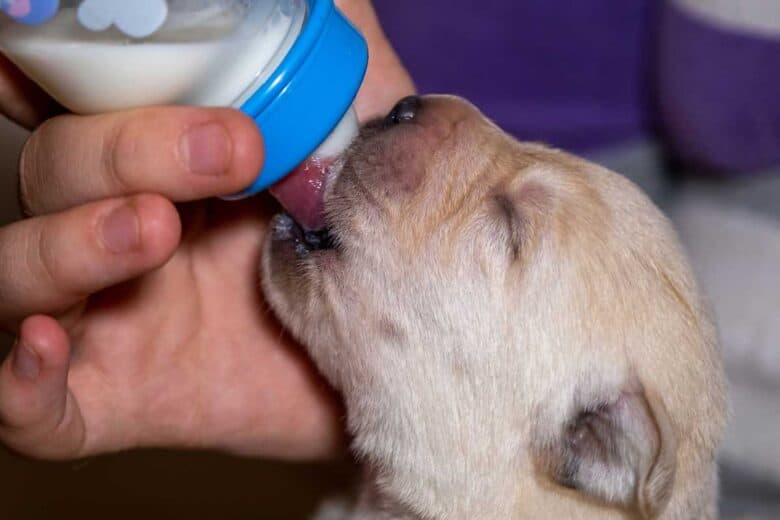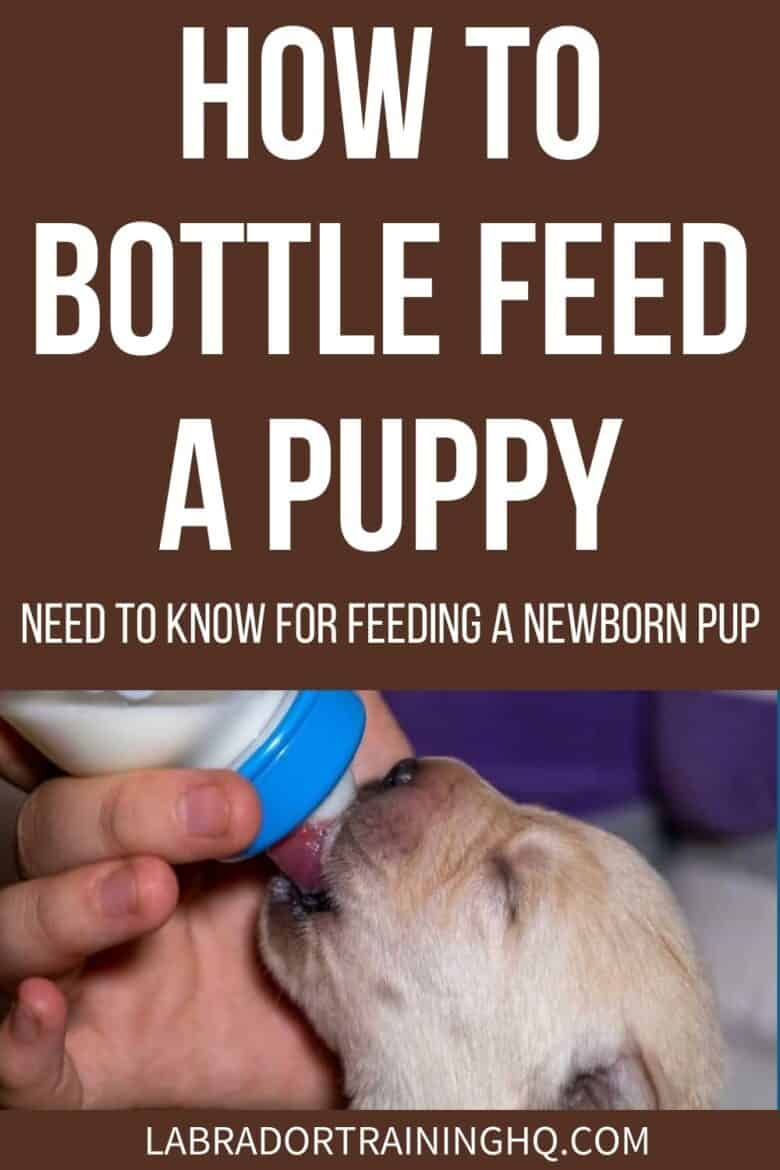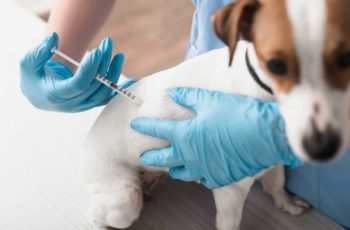This post may contain affiliate links. We may earn money or products from the companies mentioned in this post.
Until they are about a month old, puppies should ideally be fed directly from their mother.
Mother’s milk contains essential nutrients that puppies need to grow and thrive, but there are many reasons why this might not be possible, in which case you will need to bottle feed your newborn puppy using formula to ensure they get the nutrients that they need.
In this article, we will take you through exactly how to safely and effectively bottlefeed newborn pups. We’ll also share our recommendations for the best nursing formulas to feed your growing canine.

In addition, we will look briefly at why mothers might reject their puppies and choose not to nurse them, and how to tell if your puppy is getting all the nutrition that they need. We have included an FAQ section to answer the most common questions, but you can leave your own questions in the comments as well.
Contents & Quick Navigation
Why Would A Mother Reject Her Puppies?
It is not only orphaned puppies that might need formula to substitute for mother’s milk. Sometimes mothers can’t produce enough milk to feed all their pups, especially if they have a large litter.
When this happens, mother dogs will often reject one of their babies in order to have enough milk for the rest. This is completely natural, as the mother’s instinct is to ensure that as many of her pups will survive as possible.
It may also be that the puppy is too weak to latch on and suckle from her mother or compete with his siblings for access to milk.
Of course, the mother dog might just not be interested in her puppies in general if her maternal instincts don’t kick in the way that they should. This can be apparent from day one, or it could be something that happens days or weeks after her puppies are born.
There are a few key signs that a mother may be rejecting her litter, and principal among them is a lack of licking. In addition to keeping them clean, this is a way for a mother to mark her puppies with her scent. If she isn’t doing this for one or all of her puppies, this is a major red flag.
It is usually difficult to separate a mother from her litter; if your mother dog seems to be actively avoiding her pups, this is a sign that she is rejecting them.
Happy puppies that are nursing well will spend most of their time eating, sleeping, and pooping. They will prefer to spend their time snuggling up against their mother’s belly and huddled together as a pack.
If puppies up to a month old spend their time crying and squirming, this means that something is not right. It is also a warning sign if one of the pups seems to be separated from the rest.
In the most extreme circumstances, a mother may try to kill and even eat her puppies. This is instinctual and can happen if the mother dog does not recognize her puppies for some reason, and it will occur more often if the mother has had a c-section.
Read our complete guide to bringing home a new puppy here.
Best Milk Replacement Formulas
We’ve raised several litters and we always have formula on hand amongst other whelping supplies before the pup’s arrive.
If your puppies can’t nurse from their mother for any reason, you can feed them a milk replacement formula instead.
It is not dissimilar from formula for human babies, but don’t feed your puppy human baby formula. Their nutritional needs are different and they will do better with something specially formulated for them.
Below are some of the best puppy formulas that you can get today. You can also check out the emergency milk replacement recipes available on the Maddie’s Fund website.
PetAg Goat’s Milk Esbilac Powder Milk Supplement For Puppies
This is a powdered milk supplement based on goat’s milk reinforced with essential vitamins, minerals, and amino acids. It is recommended to reconstitute the milk with one part formula and two parts water, and every tablespoon will provide 13.5 calories as nutrients for your pup.
PetAg Esbilac Liquid Milk Supplement For Puppies
This liquid milk replacement formula is made from condensed skim milk and caseinate to produce an easy-to-use formula that contains everything that growing puppies need to thrive. It is particularly high in bioavailable protein and each tablespoon contains 13.2 calories.
Vets Preferred Advanced Milk RX Dog Supplement
This whey protein-based milk replacement for dogs can be given to puppies or used to nourish pregnant or lactating dogs.
It is rich in protein and fat, which is essential for growing puppies, as well as essential vitamins and minerals. The formula also includes digestive enzymes to make it a little easier for new pups to manage.
Thomas Labs Goatalac Goat Milk Replacer Powder
This powdered skimmed milk and whey protein formula from Goat’s milk is reinforced with digestive enzymes and immunoglobulins to help establish a healthy immune system for your pup from a young age.
Hartz Powdered Milk Replacer Formula
This whey protein formula is formulated to support healthy growth and development in newborn puppies with plenty of calcium, magnesium, vitamins, antioxidants, and omegas. It is designed to align closely with mother’s milk for easy digestion. Each reconstituted tablespoon contains 12 calories of nutrition.
How To Bottle Feed Your Puppy
Once you have found the right formula for your puppy, you then need to make sure that they are actually able to ingest the formula. The most common and effective approach is bottle feeding.
Puppies should be feeding on mother’s milk or formula until they are about a month old when you can start weaning them onto dog food, which should be softened to make it more digestible for them at first.
For the first month of their lives, below is a strategy for bottling feeding formula to pups.
Prepare Your Formula
It is very important to take the time to mix the formula correctly before giving it to your puppy. Add too much water, and you’ll be dealing with diarrhea. Don’t add enough, and it can cause constipation.
Both can prevent your puppy from properly absorbing the nutrients that they need and put their health and significant risk.
Also, ensure that the formula is cooled to room temperature before giving it to your dog so as not to burn their sensitive tongue and gums. Test the formula on your arm; it should feel barely warm.
Use The Right Feeder
While we might call feeding your puppy formula bottle-feeding, bottles are only one of the many tools that you might use to get your puppy to take their formula.
You might use a baby bottle, or a bottle specially designed for premature babies, but for smaller dogs, you might need to use a syringe or a sponge to drip small amounts of formula into their mouths.
If the nipple you are using does not have holes, use a needle to puncture two holes. Hold the needle over a flame for a few seconds to heat and sterilize it before puncturing the nipple.
The holes should be large enough that a little milk trickles out when you hold the bottle upside down, but small enough that your dog will need to actively suckle to get their milk.
Make sure to clean and sanitize the bottle and nipple between feeds. You should also be cleaning and sanitizing your hands before and after feeding to ensure that germs are not passing between you and your puppy.
Position Your Puppy
While it is natural to want to cradle your puppy like a baby when feeding them from a bottle, this is not the best position for them to safely take their milk. It can cause the milk to flow into their mouths and then spill over into their lungs, causing pneumonia.
When they drink from their mother they usually lie on their stomach with their head up, and you should put them in the same position when feeding them from the bottle. They can be either on a surface or on your lap in this position.
Nurse Regularly
If a newborn puppy is relying solely on you for their nutrition, you will need to nurse them very regularly. They will need formula every two hours during the day, and then once or twice more in the evening.
By the time they are three weeks old, you should be able to reduce them to about four feeds per day.
If they are reluctant to feed when you give them the bottle, this is a sign to feed them more regularly. As a general rule, smaller feeds more often are better than fewer, larger feeding sessions.
Don’t Forget To Burp Them
It is a good idea to burp newborn puppies about halfway through each feeding to ensure that air is not getting trapped where it shouldn’t. Just like with human babies, hold them over your shoulder and gently rub or pat their back until they burp naturally.
Help The Digestive Process
After eating, most puppies need a little help to eliminate the waste products produced during digestion. Mother dogs do this by licking their puppies around their belly and crotch, giving them a light massage that encourages them to poop and pee. You’ll need to do the same with a damp cloth.
Puppy poop is generally quite runny and mustard-colored, so prepare for a bit of grossness. While they won’t poop after every feed, they should be going fairly regularly.
How Much Formula Do Puppies Need?
All dogs are different, so you need to monitor your dog to understand what is right for them. As a general rule, until they are a month old puppies need approximately 3.5-3.75 calories per ounce of their body weight every 24 hours. As an example, a 6oz puppy will need about 22.5 calories per day.
Most puppy formulas contain about 1 calorie per milliliter, so it should be relatively easy to figure out how much to give them. Check the details of your chosen formula, though, as some are more nutrient-dense than others.
How Do You Know If Your Puppy Is Healthy?
If your baby puppy is getting all its nutritional needs met and digesting well, it will probably spend most of the day sleeping. It will be on a schedule of eating, pooping, and sleeping until it is about three weeks old.
They should also feel warm to the touch, as dogs are hotter than humans, and they will probably look quite plump and content after a feed with a nice round belly.
If the puppy is crying a lot and spends quite a bit of time wriggling and squirming, this means that they are likely to feel unwell and hungry.
Malnourished dogs also tend to be cold to the touch but be wary of feeding a dog while they feel cold. Puppies struggle to regulate their body temperatures and giving them liquid can cause their temperature to drop further.
Try to warm them up before attempting another feed, and organize a visit to the vet.
Read our complete guide to Labrador puppies here.
FAQs
How much do you bottle feed a puppy?
Until they are one month old, puppies need between 3.5 and 3.75 calories for every ounce of their body weight. At first, they should be fed small amounts on a regular basis, up to every two hours during the day. By the time they are three weeks old, you can cut down to about 4 feeding sessions per day.
How do you bottle feed a puppy for the first time?
When a hungry puppy realizes that there is delicious formula in the bottle they will figure out how to get at it pretty quickly, but for pups that find it difficult the best strategy is to try and replicate the instinctual experience of feeding directly from their mother.
This requires getting them into the right position–on their stomachs with their heads up–and also keeping them nice and warm. It is usually pretty cozy laying up against their mother with their littermates.
Do puppies cry when they’re hungry?
Yes, young puppies will often cry when they are hungry or when they are too full and need to defecate. If they are crying regularly, and you know they are eating, trying massaging their stomach to ease any constipation.
If you are feeding them formula, it may be that the formula is not being mixed with enough water.
At what age can puppies start drinking water?
Puppies can start drinking water once their baby teeth start to grow in, usually at around 3-4 weeks old. The eruption of the teeth generally means that a puppy has gotten the nutrition that it needs from its mother and can start eating and drinking other foods.
This is often when a mother will stop making herself available for feeding since their little teeth can hurt her nipples as well.
How many hours can a puppy go without eating?
Puppies don’t have fat reserves, so they need to eat regularly. They should go a maximum of 12 hours without feed, usually at night as you are teaching them to sleep through (and more importantly, let you sleep through).
Smaller breeds tend to need to eat more often than larger dogs as they can be prone to hypoglycemia.
When should I stop giving my puppy milk replacer?
While giving older puppies formula won’t do them any harm, they can stop taking milk replacer and start on water and solid foods once their first teeth come in. This usually happens at 3-4 weeks old.
Puppies feeding directly from their mother will often try to get milk for longer, as they enjoy the closeness, but mothers will pull away as their teeth come in.
The Verdict
There are many reasons why a puppy may be unable to feed from their mother, but they will need liquid nutrition until they are at least one month old. If you have an orphaned pup, a mother dog unwilling or unable to nurse, or a puppy too weak to nurse, you will probably need to bottlefeed them using formula.
Bottlefeeding puppies is not all that different from bottle feeding human babies. The key difference is that rather than lying them on their back, they should lie on their front with their head up like they do when they nurse from their mothers.
You will find a complete guide to bottle-feeding puppies in the above article.
Thanks to increasingly high-quality milk replacement formulas, there is no reason why even the weakest puppies shouldn’t grow up into strong and happy dogs.
Do you have experience bottle feeding puppies?
Share your thoughts and insights with the community in the comments section below.
Save To Pinterest

Top Picks For Our Dogs
- BEST PUPPY TOY
We Like: Snuggle Puppy w/ Heart Beat & Heat Pack – Perfect for new puppies. We get all of our Service Dog pups a Snuggle Puppy. - BEST CHEW TOY
We Like: KONG Extreme – Great toy for heavy chewers like our Labrador Retrievers. - BEST DOG TREATS
We Like: Wellness Soft Puppy Bites – One of our favorite treats for training our service dog puppies. - BEST FRESH DOG FOOD
We Like: The Farmer’s Dog – A couple months ago we started feeding Raven fresh dog food and she loves it! Get 50% off your first order of The Farmer’s Dog.
For a list of all the supplies we get for our new service dog puppies check out our New Puppy Checklist on the PuppyInTraining.com blog.
How To Bottle Feed A Puppy: Need To Know For Feeding A Newborn Pup was last modified: March 20th, 2022 by


